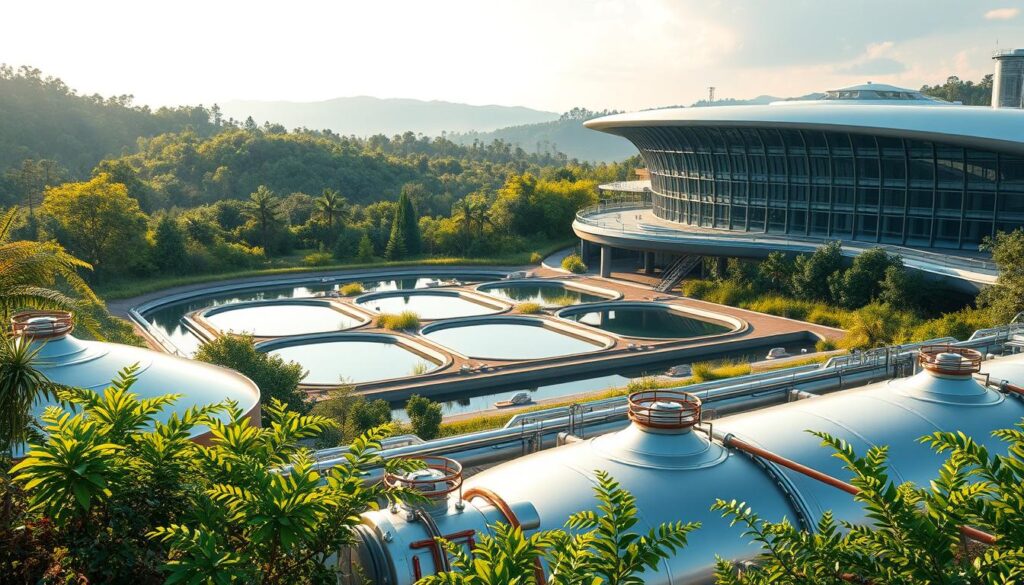The world is facing a growing water crisis, with over 80% of the world’s wastewater being released into the environment without adequate treatment. This has severe consequences on ecosystems and human health. Companies like H2O Innovation and Organica are at the forefront of developing innovative solutions for wastewater treatment engineering.
These innovative approaches are crucial for addressing the global water challenge. For instance, a new wastewater treatment facility can treat a waste stream of 150 gallons per minute, utilizing a Zero Liquid Discharge (ZLD) system that evaporates liquid waste, resulting in no wastewater discharge to the environment. Learn more about such engineering solutions.
Key Takeaways
- Innovative solutions are crucial for addressing the global water crisis.
- Companies like H2O Innovation and Organica are leading the way.
- Zero Liquid Discharge (ZLD) systems are effective in eliminating wastewater discharge.
- Advanced treatment facilities can significantly reduce environmental impact.
- Sustainable wastewater treatment engineering is key to a healthier environment.
Introduction to Wastewater Treatment Engineering
Wastewater treatment engineering plays a vital role in protecting the environment by utilizing advanced technologies to treat wastewater. This field is crucial for ensuring that water released back into the environment is safe and does not harm ecosystems.
Wastewater treatment involves several processes, including physical, chemical, and biological treatments. Physical treatments involve removing large objects and particles, while chemical treatments use chemicals to remove contaminants. Biological treatments utilize living organisms to break down organic matter.
Various technologies are employed in wastewater treatment engineering, such as membrane bioreactor systems and advanced oxidation processes. Membrane bioreactor systems combine biological treatment with membrane filtration, offering high-quality effluent. Advanced oxidation processes use oxidizing agents to remove complex pollutants.
| Treatment Process | Description | Benefits |
|---|---|---|
| Primary Treatment | Physical removal of large objects and particles | Reduces load on subsequent treatments |
| Secondary Treatment | Biological breakdown of organic matter | Removes majority of organic pollutants |
| Tertiary Treatment | Advanced chemical or physical treatment for further purification | Produces high-quality effluent |
Companies like H2O Innovation are at the forefront of providing cutting-edge technologies for wastewater treatment. Their solutions, including membrane bioreactor systems, help in achieving efficient and effective wastewater management.
The role of engineers in wastewater treatment is multifaceted. They design and implement treatment systems, ensuring that they meet regulatory standards and are environmentally sustainable. The use of advanced technologies in wastewater treatment engineering not only improves the quality of treated water but also contributes to environmental protection.
Importance of Wastewater Treatment
The importance of wastewater treatment cannot be overstated, as it directly impacts environmental protection, public health, and the economy. Effective wastewater treatment is crucial for maintaining a healthy environment, supporting economic development, and ensuring the well-being of communities.
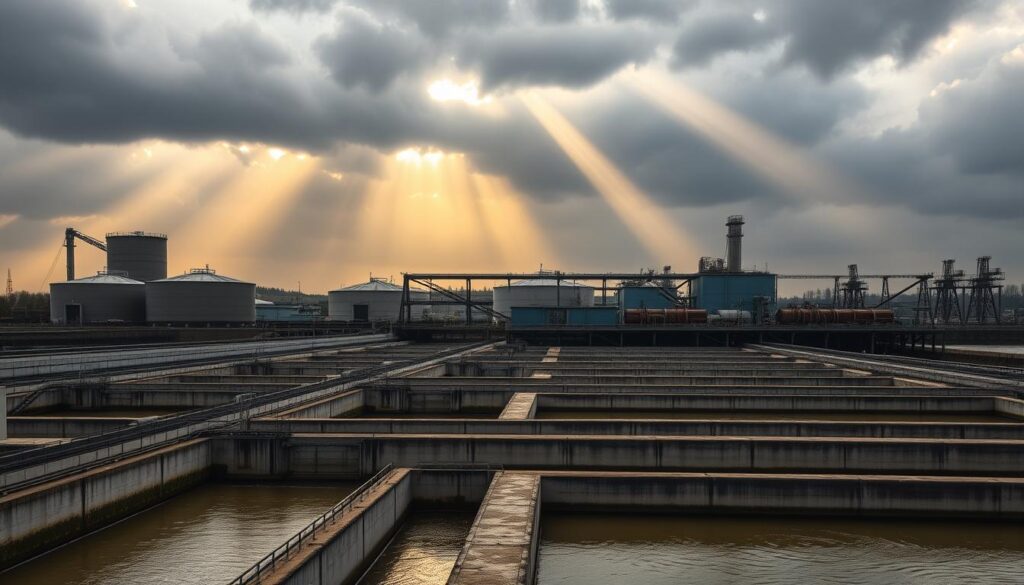
Environmental Protection
Wastewater treatment plays a vital role in protecting the environment by removing pollutants and contaminants from wastewater before it is discharged into water bodies. This process helps to:
- Preserve aquatic ecosystems
- Protect wildlife habitats
- Maintain water quality for recreational and industrial uses
Organica’s wastewater treatment facilities, for instance, are designed to be environmentally friendly and efficient, utilizing innovative technologies to minimize environmental impact.
Public Health Benefits
Effective wastewater treatment is essential for preventing the spread of diseases. By removing pathogens and other harmful substances from wastewater, treatment plants help to:
- Reduce the risk of waterborne diseases
- Protect community health
- Support overall well-being
For more information on the importance of wastewater treatment, visit https://nuwater.com/the-importance-of-wastewater-treatment/.
Economic Considerations
Wastewater treatment also has significant economic considerations. By treating wastewater effectively, communities can:
- Support economic development through the provision of clean water for industrial and agricultural uses
- Enhance property values by improving environmental quality
- Reduce costs associated with water pollution and health impacts
In conclusion, wastewater treatment is a critical component of modern infrastructure, offering numerous benefits for the environment, public health, and the economy. By investing in effective wastewater treatment solutions, communities can promote sustainable development and ensure a healthier future.
Key Processes in Wastewater Treatment
Understanding the key processes in wastewater treatment is essential for designing efficient treatment systems. Wastewater treatment plants employ a range of processes to treat wastewater, ensuring that the effluent meets regulatory standards and is safe for discharge into the environment.
Primary Treatment
Primary treatment is the first stage of wastewater treatment, where large objects and debris are removed through physical processes such as screening and grit removal. This stage also involves the removal of suspended solids and organic matter through sedimentation and flotation. Primary treatment is crucial for reducing the load on subsequent treatment stages.
Secondary Treatment
Secondary treatment involves biological processes that break down organic matter and remove nutrients from the wastewater. This stage typically employs biological wastewater treatment technologies such as activated sludge processes, trickling filters, or rotating biological contactors. Secondary treatment is designed to further reduce the concentration of organic matter and improve the overall quality of the effluent.
Tertiary Treatment
Tertiary treatment is an advanced stage of wastewater treatment that involves additional processes to further improve the quality of the effluent. This stage may include chemical treatment, filtration, and disinfection to remove remaining contaminants and pathogens. Tertiary treatment is essential for producing high-quality effluent that can be safely discharged into sensitive ecosystems or reused for various purposes.
The combination of primary, secondary, and tertiary treatment processes ensures that wastewater is thoroughly treated, meeting regulatory requirements and protecting the environment.
Innovative Technologies in Wastewater Management
Innovative technologies are revolutionizing the field of wastewater management. The industry is witnessing a significant shift towards more efficient, sustainable, and cost-effective solutions. Companies like H2O Innovation and Organica are at the forefront of this change, offering cutting-edge technologies that are transforming wastewater treatment processes.
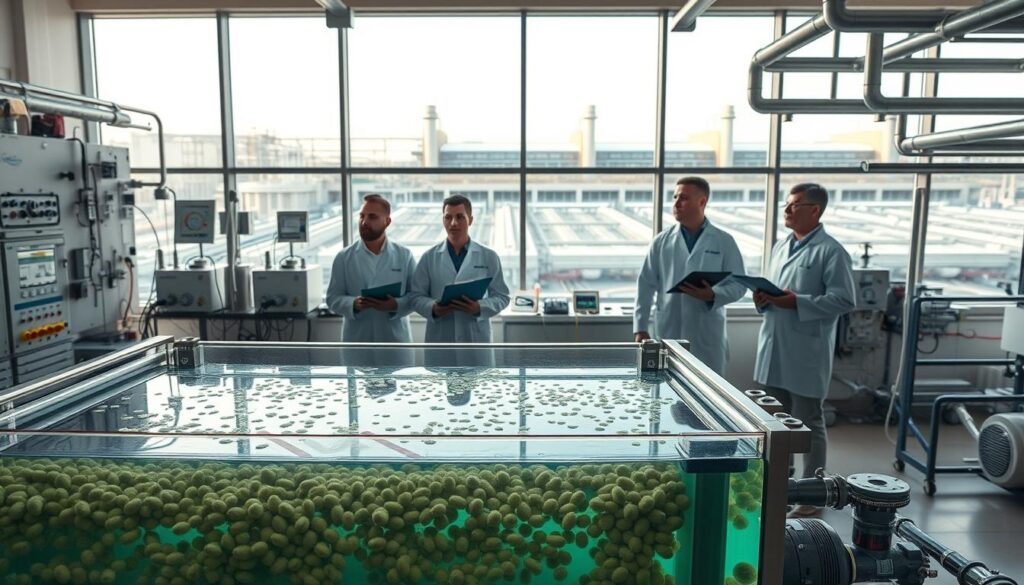
Membrane Bioreactor Systems
Membrane Bioreactor (MBR) systems represent a significant advancement in wastewater treatment technology. By combining biological treatment processes with membrane filtration, MBR systems achieve high-quality effluent that can be reused or safely discharged into the environment. These systems are particularly beneficial for industrial wastewater treatment due to their compact footprint and ability to handle varying influent conditions.
Key benefits of MBR systems include:
- High effluent quality
- Compact design
- Flexibility in handling different wastewater streams
Advanced Oxidation Processes
Advanced Oxidation Processes (AOPs) are another innovative technology gaining traction in wastewater treatment. AOPs involve the generation of highly reactive species, such as hydroxyl radicals, to degrade organic pollutants. This technology is particularly effective for treating wastewater containing recalcitrant compounds or emerging contaminants.
The advantages of AOPs include:
- Effective degradation of complex pollutants
- Potential for complete mineralization of contaminants
- Flexibility in application for various wastewater types
Biological Nutrient Removal
Biological Nutrient Removal (BNR) processes are designed to remove nitrogen and phosphorus from wastewater through biological means. These processes enhance the natural capabilities of microorganisms to uptake and convert nutrients into harmless nitrogen gas or stable forms of phosphorus. BNR is crucial for protecting water bodies from eutrophication and maintaining ecological balance.
BNR systems can be tailored to specific wastewater characteristics and treatment requirements, making them a versatile option for both municipal and industrial wastewater treatment.
Regulatory Frameworks Governing Wastewater Treatment
Understanding the regulatory landscape is essential for stakeholders in the wastewater treatment sector to ensure adherence to national and local standards.
The regulatory frameworks governing wastewater treatment are multifaceted, involving federal, state, and local regulations. At the federal level, the Environmental Protection Agency (EPA) plays a pivotal role in setting standards.
EPA Regulations Overview
The EPA sets national standards for wastewater treatment through various regulations, including the Clean Water Act. These regulations dictate the permissible levels of pollutants in treated wastewater.
For instance, the EPA’s regulations on wastewater treatment are designed to protect surface water, groundwater, and drinking water sources. Compliance with these regulations is mandatory for wastewater treatment facilities across the United States.
More information on EPA regulations can be found on the EPA’s official website.
| Regulation | Description | Impact |
|---|---|---|
| Clean Water Act | Sets standards for wastewater discharge | Protects surface water quality |
| EPA’s Effluent Guidelines | Establishes limits on pollutant discharge | Reduces pollution from industrial sources |
State-Level Regulations
In addition to federal regulations, each state has its own set of regulations governing wastewater treatment. These can be more stringent than federal standards, reflecting local environmental conditions and priorities.
State regulations may address specific issues such as nutrient pollution, water reuse, and the management of biosolids. Compliance with both federal and state regulations is crucial for the lawful operation of wastewater treatment facilities.
Local Compliance Standards
Local governments also play a significant role in regulating wastewater treatment through zoning laws, permits, and local ordinances. These regulations can affect the design, operation, and maintenance of wastewater treatment facilities.
Local compliance standards may include requirements for public outreach, environmental impact assessments, and the adoption of best management practices. Understanding and complying with these local regulations is vital for the successful implementation of wastewater treatment projects.
In conclusion, the regulatory frameworks governing wastewater treatment are complex and multi-layered. Compliance with EPA regulations, state-level regulations, and local compliance standards is essential for protecting public health and the environment.
Challenges in Wastewater Treatment Engineering
Challenges in wastewater treatment engineering are multifaceted, affecting both infrastructure and operational efficiency. The industry faces a myriad of issues that complicate the treatment process, making it essential to identify and address these challenges effectively.
Aging Infrastructure
One of the significant challenges is the aging infrastructure of wastewater treatment plants. Many facilities are operating with outdated equipment and infrastructure, which can lead to inefficiencies and increased maintenance costs. For instance, older plants may not be equipped to handle the latest technologies or the increasing demands of a growing population.
Key issues with aging infrastructure include:
- Deteriorating pipes and equipment
- Increased risk of failures and breakdowns
- Inefficiencies in treatment processes
Upgrading or replacing aging infrastructure is crucial for improving the efficiency and reliability of wastewater treatment services.
Climate Change Impacts
Climate change poses another significant challenge to wastewater treatment engineering. Rising temperatures and changing precipitation patterns can affect the quality and quantity of wastewater, making treatment more complex.
Climate change impacts on wastewater treatment include:
- Increased stormwater runoff, leading to higher volumes of wastewater
- Changes in water temperature affecting biological treatment processes
- Potential for more frequent and severe weather events
Adaptation strategies are necessary to mitigate these impacts and ensure the resilience of wastewater treatment infrastructure.
Cost Management and Funding
Managing costs and securing funding are critical challenges in wastewater treatment engineering. The high cost of infrastructure upgrades, energy consumption, and compliance with regulations can strain municipal budgets.
“The financial burden of maintaining and upgrading wastewater infrastructure is a significant concern for municipalities, requiring innovative financing solutions and cost management strategies.”
Effective cost management strategies include:
- Implementing energy-efficient technologies
- Optimizing treatment processes to reduce chemical and energy use
- Exploring alternative funding sources and public-private partnerships

Addressing these challenges requires a comprehensive approach that involves technological innovation, financial planning, and regulatory compliance. By understanding and tackling these challenges, the wastewater treatment engineering sector can move towards more sustainable and effective solutions.
Sustainable Practices in Wastewater Treatment
As concerns about environmental sustainability grow, the wastewater treatment sector is adopting innovative practices to reduce its ecological footprint. Sustainable practices in wastewater treatment are crucial for minimizing the environmental impact of treatment processes.
Water Reuse and Recycling
One of the key sustainable practices in wastewater treatment is water reuse and recycling. By treating wastewater to a high standard, it can be reused for various purposes, such as irrigation, toilet flushing, and even drinking water in some cases. This not only conserves freshwater resources but also reduces the amount of wastewater discharged into the environment.
“Water reuse and recycling are essential components of a sustainable water management strategy.” Facilities like Organica’s are designed with sustainability in mind, incorporating advanced technologies to maximize water reuse and minimize environmental impact.
Energy Recovery Techniques
Energy recovery techniques are another vital aspect of sustainable wastewater treatment. Processes such as anaerobic digestion can produce biogas, which can be used to generate electricity or heat, reducing the energy consumption of treatment plants. Implementing energy-efficient technologies not only reduces operational costs but also decreases the carbon footprint of wastewater treatment.
Green Infrastructure Approaches
Green infrastructure approaches, including the use of wetlands, green roofs, and permeable pavements, can also play a significant role in sustainable wastewater management. These natural systems can help to filter and treat wastewater, reduce stormwater runoff, and provide habitats for wildlife. By integrating green infrastructure into wastewater treatment strategies, communities can enhance the sustainability of their water management practices.
In conclusion, the adoption of sustainable practices in wastewater treatment, such as water reuse and recycling, energy recovery techniques, and green infrastructure approaches, is crucial for reducing the environmental impact of treatment processes. As the sector continues to evolve, the integration of advanced technologies and innovative practices will be key to achieving a more sustainable future.
The Role of Engineers in Treatment Plant Design
As the demand for clean water continues to grow, engineers are at the forefront of designing wastewater treatment plants that are efficient, sustainable, and meet the needs of the communities they serve. Effective design is crucial for producing high-quality effluent and ensuring that treatment plants operate within environmental regulations.
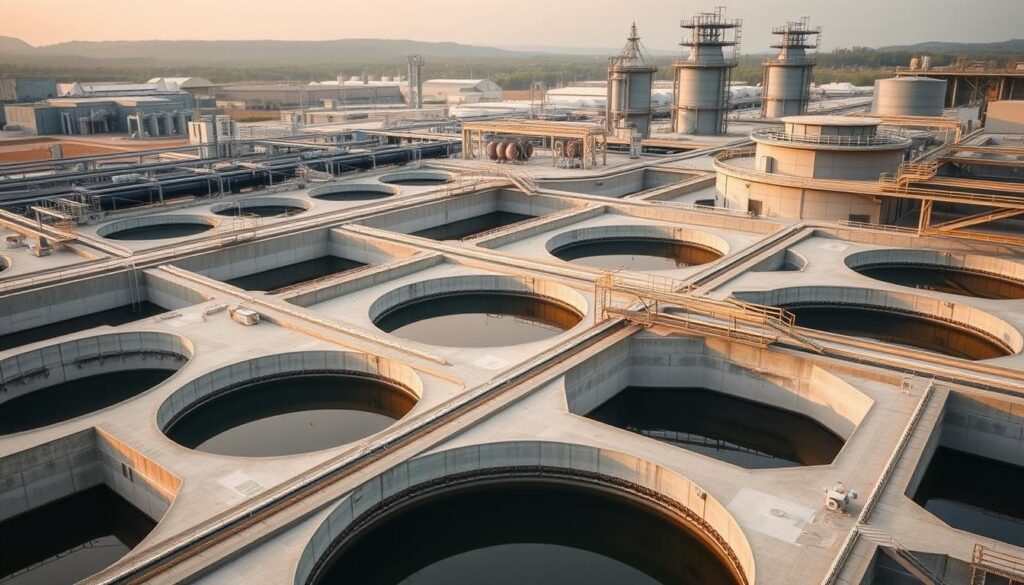
Understanding Community Needs
Engineers must have a deep understanding of the community’s needs, including population growth projections, water usage patterns, and specific environmental concerns. This involves collaboration with local stakeholders to ensure that the treatment plant design is tailored to the community’s specific requirements. For instance, H2O Innovation’s engineers work closely with clients to design and implement effective wastewater treatment systems that address these needs.
Incorporating Cutting-Edge Technologies
The incorporation of cutting-edge technologies is vital for enhancing the efficiency and sustainability of wastewater treatment plants. Engineers leverage advancements in fields such as membrane bioreactor systems, advanced oxidation processes, and biological nutrient removal to create innovative treatment solutions. These technologies not only improve the quality of the treated water but also reduce energy consumption and operational costs.
Collaboration with Stakeholders
Collaboration is a key aspect of successful treatment plant design. Engineers work with a range of stakeholders, including regulatory bodies, local communities, and other experts, to ensure that the design meets all necessary standards and expectations. This collaborative approach helps in identifying potential issues early in the design process, thereby reducing the risk of costly revisions or compliance problems down the line.
By understanding community needs, incorporating the latest technologies, and collaborating with stakeholders, engineers play a pivotal role in designing wastewater treatment plants that are not only effective but also sustainable and compliant with regulatory requirements.
Case Studies of Successful Projects
Case studies of wastewater treatment projects provide valuable insights into innovative solutions that have been successfully implemented. These studies not only highlight the technical advancements in the field but also demonstrate the importance of community engagement and adaptability in the face of challenges.
Innovative Treatment Facilities
Companies like H2O Innovation and Organica have been at the forefront of developing innovative wastewater treatment facilities. For instance, H2O Innovation has implemented advanced membrane technologies that significantly improve water quality. Organica, on the other hand, has focused on biological treatment processes that are both efficient and environmentally friendly.
One notable example is the wastewater treatment plant designed by Organica for a municipal client. This plant utilizes a unique biological treatment process that not only treats wastewater effectively but also produces a high-quality effluent that can be reused for various purposes.
Community Engagement Success Stories
Successful wastewater treatment projects often involve significant community engagement. This can include public education campaigns, community outreach programs, and involvement in the planning process. By engaging with the community, treatment plants can build trust and ensure that their operations are aligned with community needs and expectations.
A case in point is a project by H2O Innovation that included a comprehensive community engagement program. The program involved regular updates, public meetings, and educational workshops, which helped to foster a positive relationship between the project team and the local community.
Lessons Learned from Failures
Not all wastewater treatment projects are successful, and there are valuable lessons to be learned from those that encounter difficulties. Analyzing failures can provide insights into common pitfalls and how they can be avoided in future projects.
For example, a project that faced significant delays due to unforeseen technical issues learned the importance of thorough site investigation and contingency planning. This experience has informed their approach to subsequent projects, highlighting the value of flexibility and robust planning.
Wastewater Treatment in the Context of Urbanization
The rapid pace of urbanization worldwide has profound implications for wastewater management and treatment. As cities expand, the demand for effective wastewater treatment services increases, posing significant challenges for municipal wastewater treatment systems.

Managing Increased Demand
Urbanization leads to a surge in population, resulting in increased wastewater generation. Effective management of this increased demand requires innovative solutions and robust infrastructure. Cities must adopt strategies that not only enhance treatment capacity but also ensure the quality of treated water.
“The key to managing increased demand lies in adopting flexible and scalable wastewater treatment technologies,” says an expert in the field. This approach enables cities to adapt to changing demands without compromising on treatment efficiency.
Smart City Initiatives
Smart city initiatives offer a promising avenue for enhancing wastewater treatment. By leveraging advanced technologies such as IoT sensors and data analytics, cities can optimize treatment processes, predict maintenance needs, and improve overall efficiency.
- Implementing real-time monitoring systems
- Utilizing data analytics for predictive maintenance
- Adopting energy-efficient treatment technologies
Integrating Wastewater Treatment with Urban Planning
Effective wastewater treatment in urban areas requires seamless integration with urban planning. This involves designing cities with wastewater management in mind, incorporating green infrastructure, and ensuring that treatment facilities are strategically located to serve growing populations.
By integrating wastewater treatment with urban planning, cities can create sustainable and resilient water management systems. This holistic approach not only addresses current challenges but also prepares cities for future growth and potential environmental changes.
Future Trends in Wastewater Treatment Engineering
Future trends in wastewater treatment engineering are expected to revolutionize the way we manage wastewater, making it more sustainable and efficient. The industry is on the brink of a significant transformation, driven by technological advancements and the need for more resilient infrastructure.
Adoption of Artificial Intelligence
The integration of artificial intelligence (AI) in wastewater treatment is set to enhance operational efficiency and predictive maintenance. AI algorithms can analyze vast amounts of data from treatment plants, identifying patterns and predicting potential issues before they become critical.
This proactive approach not only reduces downtime but also optimizes energy consumption and chemical usage, leading to more cost-effective operations.
Biotechnological Advancements
Biotechnological advancements are playing a crucial role in improving wastewater treatment processes. Innovative biological treatments can more effectively remove contaminants and nutrients from wastewater, reducing the environmental impact.
These advancements also open up new possibilities for water reuse and recycling, contributing to a more circular economy in water management.
Climate Resilience Strategies
As climate change continues to pose challenges to wastewater infrastructure, climate resilience strategies are becoming increasingly important. This includes designing treatment plants that can withstand extreme weather events and adapting operations to changing environmental conditions.
By incorporating climate resilience into wastewater treatment engineering, communities can better protect public health and the environment.
Economic Impacts of Wastewater Treatment Solutions
Investing in wastewater treatment solutions can have far-reaching economic benefits. The economic impacts of these solutions are multifaceted, influencing various aspects of the economy, from job creation to cost savings and investment opportunities.
Job Creation in the Sector
Wastewater treatment projects create numerous job opportunities, both directly and indirectly. Direct employment occurs in the construction, operation, and maintenance of treatment facilities. Indirectly, jobs are created in industries that supply materials and services to these projects. According to a study on the economic impact of wastewater treatment plants, for every job created in the wastewater sector, additional jobs are generated in related industries.
| Job Category | Number of Jobs Created | Economic Impact |
|---|---|---|
| Direct Employment | 500 | $20 million |
| Indirect Employment | 750 | $30 million |
| Induced Employment | 1000 | $40 million |
For more detailed information on the economic impact of wastewater treatment plants, visit NetSol Water.
Cost Savings through Efficiency
Efficient wastewater treatment solutions lead to significant cost savings. Advanced technologies reduce energy consumption and minimize waste, resulting in lower operational costs. Moreover, efficient treatment processes can recover valuable resources such as water and energy, further enhancing cost savings.

Investment Opportunities
The wastewater treatment sector presents numerous investment opportunities. As the demand for clean water increases, investments in advanced treatment technologies and infrastructure become more attractive. Public-private partnerships are becoming a popular model for financing wastewater treatment projects, offering a viable solution for municipalities looking to upgrade their facilities.
In conclusion, the economic impacts of wastewater treatment solutions are substantial, offering benefits such as job creation, cost savings, and investment opportunities. As the world continues to urbanize, the importance of efficient and effective wastewater treatment will only continue to grow.
Community Involvement in Wastewater Management
Wastewater management is a collective responsibility that requires active community participation. Effective management of wastewater is crucial for environmental protection, public health, and economic sustainability. Community involvement plays a pivotal role in achieving these goals by fostering a culture of responsibility and cooperation.
Education and Awareness Programs
Education and awareness are foundational elements of community involvement in wastewater management. By educating the public about the importance of proper wastewater disposal and treatment, communities can reduce contamination and promote sustainable practices. Programs can include workshops, school curricula, and public campaigns that highlight the impact of wastewater on the environment and public health.
For instance, a community might implement a program to educate residents on what can and cannot be flushed down toilets and drains, thereby reducing the risk of clogs and contamination. Such initiatives not only improve wastewater management but also foster a sense of community responsibility.
Volunteer Initiatives
Volunteer initiatives are another critical aspect of community involvement. By participating in clean-up events, monitoring water quality, and assisting in educational programs, volunteers can significantly contribute to wastewater management efforts. These activities not only help maintain the infrastructure but also raise awareness and build a sense of ownership among community members.
For example, a local non-profit organization might organize a river clean-up event, engaging community members in the effort to reduce pollution and improve water quality. Such events are invaluable for building community cohesion and promoting environmental stewardship.
Building Trust with Residents
Building trust between the community and wastewater management authorities is essential for the success of any wastewater management plan. Transparency in operations, regular communication, and responsiveness to community concerns are key to establishing this trust. By engaging with residents and addressing their concerns, wastewater management agencies can foster a collaborative environment that supports effective wastewater management.
Trust can be built through regular updates on wastewater management projects, public meetings, and responsive customer service. For instance, providing clear information on how wastewater is treated and reused can alleviate concerns and promote understanding among community members.
| Initiative | Benefits | Community Impact |
|---|---|---|
| Education and Awareness | Reduces contamination, promotes sustainable practices | Fosters a culture of responsibility |
| Volunteer Initiatives | Maintains infrastructure, raises awareness | Builds community cohesion, promotes environmental stewardship |
| Building Trust | Fosters collaboration, supports effective management | Promotes transparency and understanding |
For more information on community engagement in wastewater management, visit Racoman’s blog on community engagement. This resource provides valuable insights into the basics of community engagement for operators in the wastewater industry.
Maintenance and Operations of Treatment Plants
Effective maintenance and operations are crucial for the smooth functioning of wastewater treatment plants. Ensuring that these facilities operate efficiently is vital for environmental protection and public health.
Importance of Regular Maintenance
Regular maintenance is the backbone of wastewater treatment plant operations. It involves routine checks and repairs to prevent equipment failures and ensure that the plant operates within designated parameters. Companies like H2O Innovation provide operation and maintenance services for wastewater treatment systems, highlighting the importance of professional maintenance.
Key aspects of regular maintenance include:
- Routine inspections of equipment and infrastructure
- Preventive maintenance to avoid major repairs
- Timely replacement of worn-out parts
Best Practices for Operators
Operators play a critical role in the day-to-day operations of wastewater treatment plants. Adopting best practices can significantly enhance the efficiency and effectiveness of treatment processes.
Some best practices include:
- Continuous monitoring of plant performance
- Adherence to standard operating procedures
- Ongoing training and professional development
Technology in Operational Efficiency
Technology has revolutionized the operations of wastewater treatment plants. Advanced technologies such as SCADA systems, IoT devices, and data analytics tools help in optimizing operations, predicting maintenance needs, and improving overall efficiency.
| Technology | Application | Benefits |
|---|---|---|
| SCADA Systems | Real-time monitoring and control | Enhanced operational efficiency, quick response to issues |
| IoT Devices | Remote monitoring of equipment | Predictive maintenance, reduced downtime |
| Data Analytics | Analysis of operational data | Optimized processes, cost savings |

By embracing technology and adhering to best practices, wastewater treatment plants can achieve higher levels of efficiency and effectiveness, ultimately contributing to better environmental outcomes.
Role of Water Quality Monitoring
The importance of water quality monitoring cannot be overstated in the context of wastewater treatment engineering. Effective monitoring ensures that wastewater treatment processes are operating within designated parameters, safeguarding both the environment and public health.
Techniques and Tools
Various techniques and tools are employed in water quality monitoring, ranging from traditional sampling methods to advanced real-time monitoring systems. Remote sensing technologies and online sensors are increasingly being used to monitor water quality parameters such as pH, turbidity, and nutrient levels.
The use of these advanced tools enables wastewater treatment plants to respond quickly to changes in water quality, thereby preventing potential environmental hazards. For instance, online sensors can continuously monitor water parameters, sending alerts when deviations from set standards occur.

Importance of Real-Time Data
Real-time data is crucial in water quality monitoring as it allows for immediate response to emerging issues. This capability is particularly important in wastewater treatment, where timely interventions can prevent the release of untreated or partially treated wastewater into the environment.
By leveraging real-time data, treatment plants can optimize their operations, reduce energy consumption, and minimize the risk of non-compliance with regulatory standards. Predictive analytics further enhance the ability to forecast potential issues, enabling proactive maintenance and operation.
Regulatory Compliance
Water quality monitoring is also essential for ensuring regulatory compliance. Wastewater treatment plants must adhere to strict standards regarding the quality of effluent discharged into water bodies. Regular monitoring and reporting are required to demonstrate compliance with these regulations.
| Regulatory Aspect | Description | Monitoring Requirement |
|---|---|---|
| EPA Standards | Guidelines for effluent quality | Regular sampling and analysis |
| State-Level Regulations | Additional state-specific requirements | Varies by state; often more frequent monitoring |
| Local Compliance Standards | Local ordinances and permits | Continuous monitoring with real-time reporting |
By maintaining rigorous water quality monitoring practices, wastewater treatment plants can ensure compliance with regulatory requirements, protecting both the environment and public health.
Workforce Development and Training
As the wastewater engineering field continues to evolve, the need for comprehensive workforce development and training programs becomes increasingly important. The industry’s ability to adapt to new technologies, regulatory requirements, and environmental challenges depends significantly on having a well-trained and competent workforce.
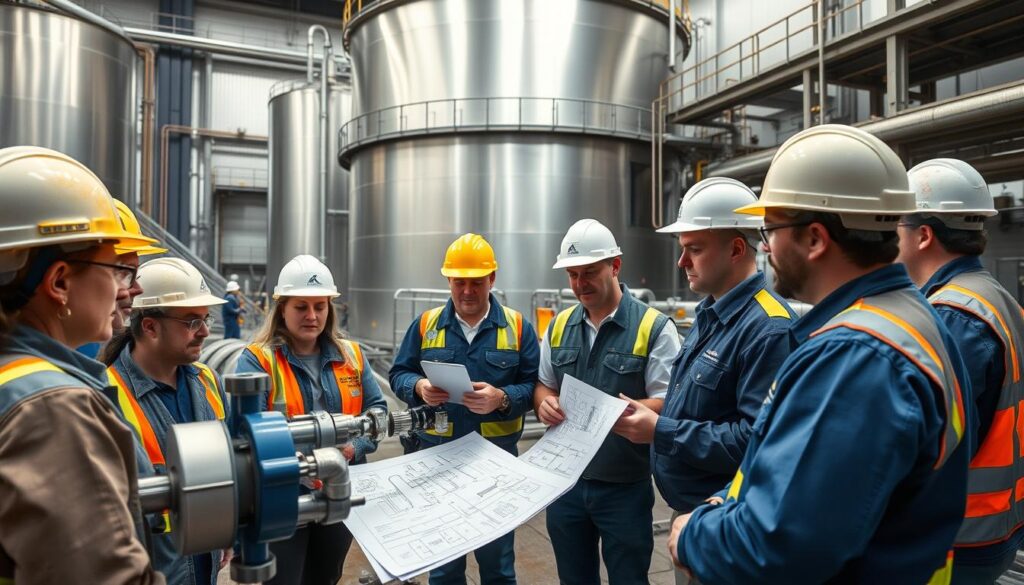
Technical Training Programs
Technical training programs are crucial for equipping wastewater treatment professionals with the necessary skills to operate and maintain complex treatment systems. These programs should cover a wide range of topics, including process control, equipment maintenance, and safety procedures. By investing in technical training, wastewater treatment plants can improve operational efficiency and reduce the risk of accidents.
Moreover, technical training programs can be tailored to address specific needs within the industry, such as the operation of new technologies or compliance with regulatory standards. This targeted approach ensures that the workforce is always up-to-date with the latest developments in wastewater treatment.
Education Partnerships
Education partnerships between wastewater treatment organizations and educational institutions play a vital role in developing the next generation of professionals. These partnerships can facilitate the creation of curricula tailored to the industry’s needs, ensuring that graduates are job-ready and equipped with the latest knowledge and skills.
Furthermore, education partnerships can also support ongoing professional development through workshops, seminars, and certification programs. This collaborative approach helps to foster a culture of continuous learning and improvement within the industry.
Future Skills for Wastewater Engineering
The future of wastewater engineering will be shaped by several key trends, including the adoption of digital technologies, sustainable practices, and climate resilience strategies. As such, the workforce will need to develop skills in areas such as data analysis, process optimization, and environmental management.
Investing in workforce development and training is not only a necessity for addressing current challenges but also a strategic move towards preparing the industry for future demands. By focusing on technical training programs, education partnerships, and future skills, the wastewater treatment sector can ensure a competent and adaptable workforce.
Conclusion: The Future of Wastewater Treatment Engineering
Wastewater treatment engineering is crucial for a sustainable future, addressing the challenges of climate change and population growth. As discussed, innovative solutions such as advanced water purification systems, water recycling technologies, and decentralized water treatment are being developed.
Key Takeaways
The importance of wastewater treatment lies in its impact on environmental protection, public health, and economic considerations. Engineers play a vital role in designing treatment plants that incorporate cutting-edge technologies and meet community needs.
Moving Forward
A call to action is necessary to promote sustainable solutions in wastewater treatment engineering. This involves collaboration with policy makers to support the development and implementation of innovative technologies. For more information on the role of engineering in tackling grand challenges, visit World Civil Society.
